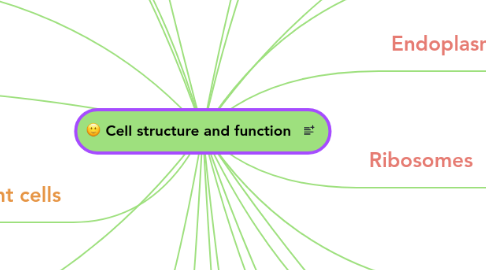
1. Blood
1.1. Red blood cells ( Erythrocytes)
1.2. White blood cells ( Leukocytes )
1.2.1. Granulocytes
1.2.2. Neutrophils
1.2.3. eosinophils
1.2.4. Basophils
1.2.5. Agranulocytes
1.2.6. Lymphocytes
1.2.7. Monocytes
1.3. Platelets ( Trombocytes)
2. Muscle tissues
2.1. smooth muscle
2.1.1. involuntary muscles
2.2. striated muscles
2.2.1. known as skeletal muscle
2.3. cardiac muscles
2.3.1. only found in heart
3. Epithelial tissues
3.1. squomous epithelium
3.2. cuboidal epithelium
3.3. columnar epithelium
3.4. sratified epithelium
3.4.1. stratified squamous
3.4.1.1. found in epidermis of skin and in the lining of the innermost layer of esophagus
3.4.2. sratified cuboidal
3.4.2.1. found in the excretory duct of sweat glands
3.4.3. stratified columnar
3.4.3.1. found in the secretory ducts of the mamary glands
3.5. pseudostratified epithelium
3.5.1. appear to be layer but layer do not exist
4. Bones
4.1. act as lever
4.1.1. converting muscle contraction into movement
4.2. Spongy bones
4.2.1. found in the center of flat bones and in the end of long bones
4.3. Compact bones
4.3.1. form by osteocytes located in the lacunae
5. Nerve tissues
5.1. neurones
5.1.1. a cell body
5.1.2. dendrites
5.1.3. the axon
5.2. neuroglial cells
6. Plant cells
6.1. have fixed shape
6.2. have cell wall
6.3. have vacuoles
6.3.1. maintaining turgidity of cells
6.4. have chloroplast
6.4.1. contain chloropyll for photosynthesis
6.5. food storage at starch
6.6. do not have centrioles
7. Animal cells
7.1. do not have fixed shape
7.2. do not have cell wall
7.3. do not have vacuoles
7.4. do not have chloroplast
7.5. food storage at glycogen
7.6. have centrioles
8. Eukaryotic cells
8.1. Consist plants,animals,funfi,slieme moulds,protozoa and algae
8.2. chromosome are present
8.3. have distinct nucleus
8.4. many membranous organelles
8.5. cell wall was made by cellulose
8.6. undergo mitosis and meiosis
9. Prokaryotic cells
9.1. Consist of bacteria and archeabacteria
9.2. no chromosom,only circular DNA stands
9.3. no nucleus
9.4. cell wall made by peptidoglycan
9.5. undego binary fusion
10. to digest macromolecules in the cells
11. recycling centre
12. Cell wall
12.1. tough, rigid, thick non-living structure
12.2. give very difine shapes
12.3. Function:
12.3.1. maintaining the shape of the cells
12.3.2. providing strength and give mechanical support
12.3.3. maintains the turgidity of cells
12.3.4. allow exchange substance during homeostasis
12.3.5. an important reserve of carbohydrates
13. Plasma membrane
13.1. encloses the cytoplasm/protoplasm of the cells
13.2. provides shape and protection for cells
13.3. semi-permeable or selective permeable
13.4. protein are embedded in phospholipid bilayer
14. Cytoskeleton
14.1. made of filamentous protein networks and skeleton of the cells
14.2. microfilament
14.3. microtubules
14.4. intermediate filaments
15. Nucleus
15.1. largest and most prominent organelle
15.2. oval or sperical shape
15.3. store genetic material in the form of DNA
15.4. Nucleolus
15.4.1. to synthesize ribosomal RNA subunits for the synthesis of protein
16. Endoplasmic Reticulum(ER)
16.1. Rough endoplasmic reticulum(RER)
16.1.1. next to nucleus
16.1.2. synthesizing protein,modifying,packaging and transport of secretory proteins
16.2. Smooth endoplasmic reticulum(SER)
16.2.1. diverse metabolics activities
17. Ribosomes
17.1. small,solid, spherical granules
17.2. an assembly of two ribosomal RNA(rRNA) that are synthesizedd in nucleus
17.3. synthesized protein molecules
18. Mitocondria
18.1. bounded by two layerof membrane
18.2. the cristae partially divide by mitochondrial fluid called mitochondrial matrix
18.3. mitochondrial matrix contains enzymes, DNA and ribosomes
18.4. powerhouse of cell
18.4.1. energy production for the cell
19. Chloroplast
19.1. biconvex disc shape
19.2. have their own DNA, RNA and ribosomes
19.2.1. enclosed by two memmbranes separated by intermembrene space
20. Lysosomes
20.1. contains hydrolytic enzymes
20.2. also digest the remains of dead organelle(autolysis process)
21. Golgi body
21.1. consist of a stack of flattened membranous sacs known as cisterinae
21.2. dark spherical bodies, recyling center of the cell
21.3. receives,stores,concetrate,modifies,finishes and sorts proteins
22. Cartilage
22.1. Hyaline cartilafge
22.1.1. most common form
22.2. Elastic cartilage
22.2.1. contains many elastic fibers giving int a yellowish color
22.3. Fibrous cartilage
22.3.1. contains a dense network of collagenn fibers

